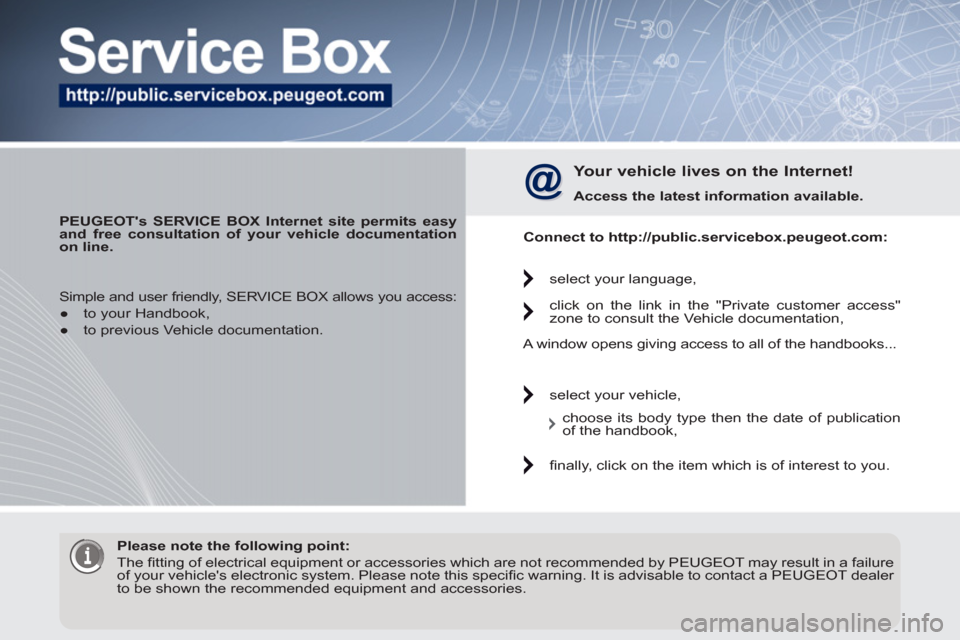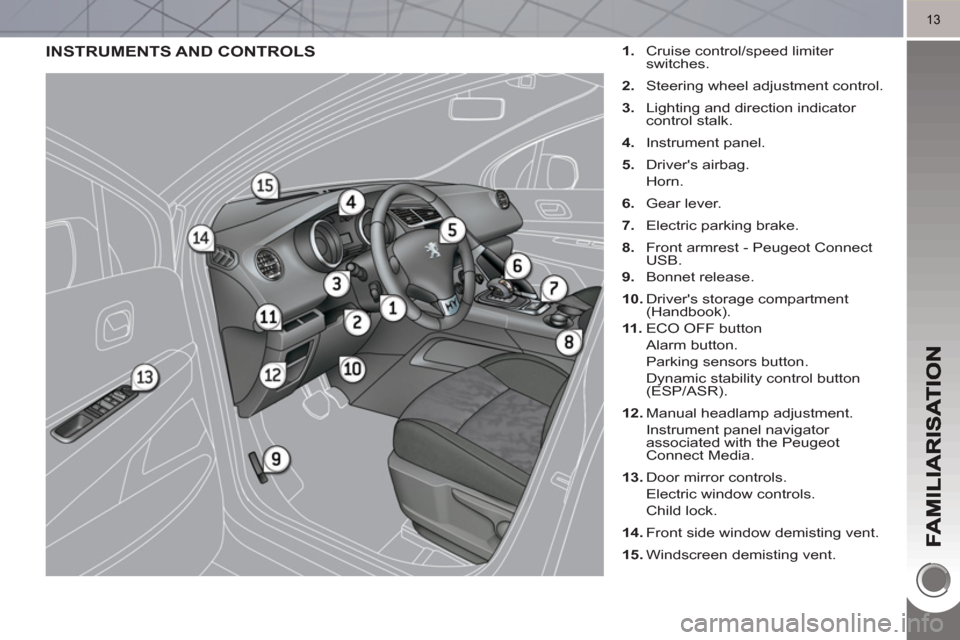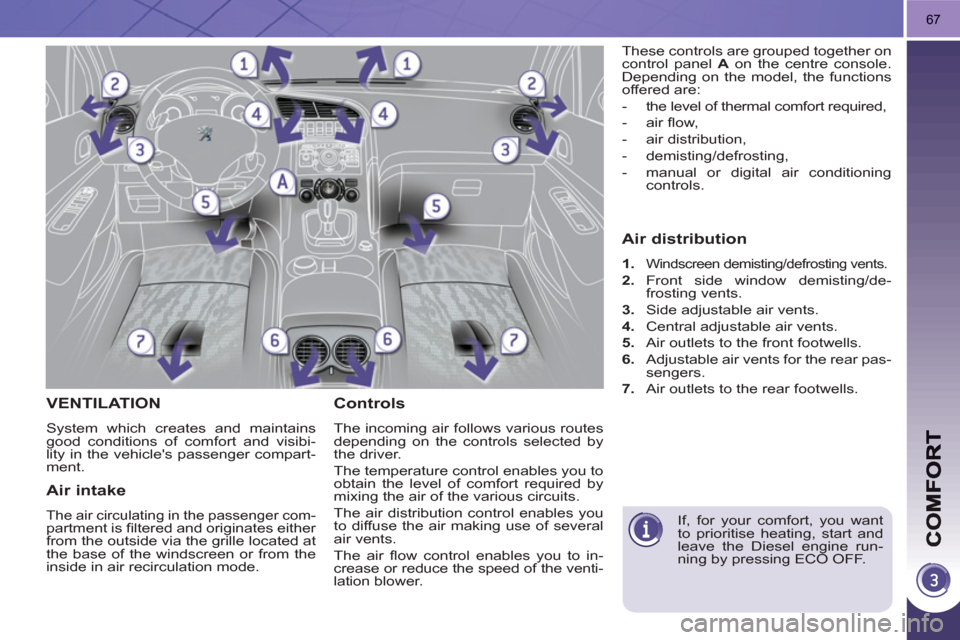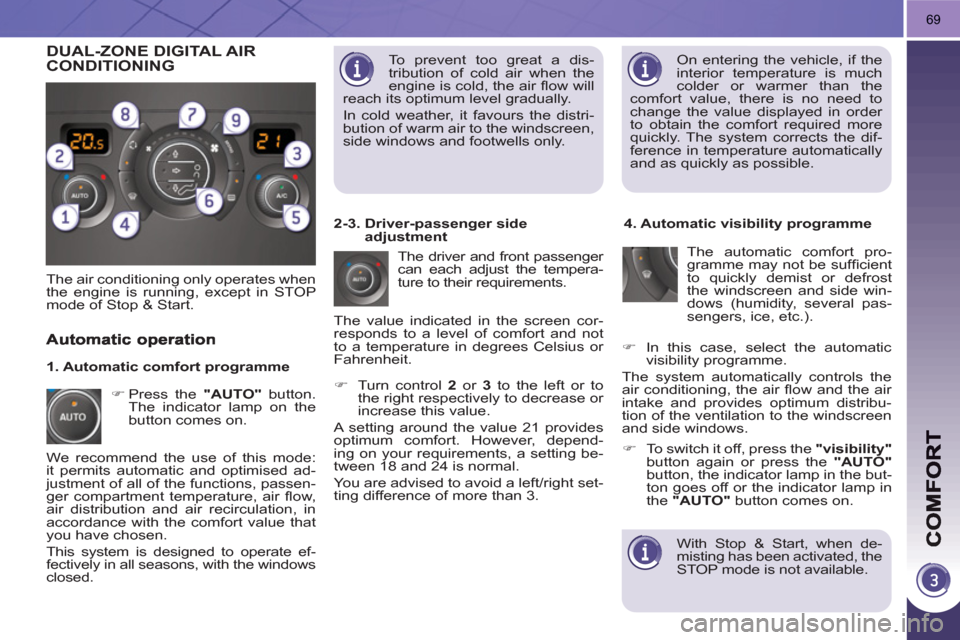2011 Peugeot 3008 Hybrid 4 window
[x] Cancel search: windowPage 2 of 280

PEUGEOT's SERVICE BOX Internet site permits easy
and free consultation of your vehicle documentation
on line.
Your vehicle lives on the Internet!
Access the latest information available.
Connect to http://public.servicebox.peugeot.com:
Simple and user friendly, SERVICE BOX allows you access:
●
to your Handbook,
●
to previous Vehicle documentation.
Please note the following point:
The fi tting of electrical equipment or accessories which are not recommended by PEUGEOT may result in a failure
of your vehicle's electronic system. Please note this specifi c warning. It is advisable to contact a PEUGEOT dealer
to be shown the recommended equipment and accessories. select your language,
click on the link in the "Private customer access"
zone to consult the Vehicle documentation,
select your vehicle,
fi nally, click on the item which is of interest to you. choose its body type then the date of publication
of the handbook, A window opens giving access to all of the handbooks...
Page 4 of 280

FAMILIARISATION4-25
INSTRUMENTS and CONTROLS 43-57
CHILD SAFETY 117-125
MULTIFUNCTION SCREENS58-66
SAFETY 126-135
COMFORT 67-80
ACCESS 81-95
VISIBILITY 96-105
FITTINGS 106-116
Instrument panels .............43Indicator and warning lamps....45Indicators..........................53Adjustment buttons...........57
Child seats.......................117ISOFIX child seats..........122Child lock........................125
Screen C (Peugeot Connect Sound)...5816/9 high definition retractablecolour screen (PeugeotConnect Media) ................61
Direction indicators.........126Hazard warning lamps....126Horn................................126
ESP system....................127Front seat belts...............129Airbags ...........................132
Ventilation .........................67Rear screen demist/defrost.................68Dual-zone digital air conditioning....................69
Front seats.......................72Rear seats........................76Steering wheel adjustment...........78Mirrors ..............................79
Remote control key..........81Alarm................................86Electric windows...............88Doors ................................90
Boot..................................92Lower tailgate ...................93Fuel tank ...........................94Misfuel prevention ............95
Lighting controls...............96Automatic illumination of headlamps ..................99Headlamp adjustment......99Wiper controls................100
Automatic rainsensitive wipers ............102Courtesy lamps ..............103Interior mood lighting......104Boot lamp.......................105
Interior fittings.................106Front armrest..................108Rear multimedia..............110
Panoramic sunroof..........f112Boot fittings......................113
HYBRID SYSTEM 26-42
Page 10 of 280

8
FOR ECONOMICAL DRIVING, CARING FOR THE ENVIRONMENT
Main recommendations for driving economically
Gear lever
Use the automatic
mode A
as much
as possible as this optimises gear
changes to suit the requirements.
The fuel consumption
of a vehicle varies greatly
:
- according to the driver's style of driving
(moderate, aggressive, fast, ...),
- according to the type of journeys
made (urban, main road, motorway, fl ow-
ing, heavy traffi c, …) and the speed.
Hybrid mode selector
To optimise fuel consumption, use the
Auto
mode
of the selector whenever
possible (the mode is activated auto-
matically when starting) including for
urban journeys.
This mode optimises the use of the en-
ergy sources (internal combustion en-
gine and/or electric) contrary to other
modes, which are for use in particular
cases.
Stay in the "eco" zone
indicated in the
power meter: accelerate gently, drive at
steady speeds using the speed limiter
or cruise control as soon as possible.
Causes of high consumption and
checks
As with any vehicle, limit overloading,
wind resistance (windows open above
30 mph (50 km/h), roof rack, loaded or
not, …), the use of power consumers
(air conditioning, heated seats, heated
rear screen, …).
Observe the recommendations on
checks (regular check of tyre pres-
sures, correct tyre pressures, …) and
routine servicing.
Consumption history
See the impact of your style of driving
and the type of journey by reviewing
the history of your energy consumption.
Refer to the "Multifunction screens"
section.
Use the "charge"
zone: anticipate the
need to slow down by taking your foot
off the accelerator rather than braking.
The movement of the power meter nee-
dle (into the "charge" zone), indicates
the level of energy recovery.
Drive smoothly
Page 15 of 280

13
INSTRUMENTS AND CONTROLS
1.
Cruise control/speed limiter
switches.
2.
Steering wheel adjustment control.
3.
Lighting and direction indicator
control stalk.
4.
Instrument panel.
5.
Driver's airbag.
Horn.
6.
Gear lever.
7.
Electric parking brake.
8.
Front armrest - Peugeot Connect
USB.
9.
Bonnet release.
10.
Driver's storage compartment
(Handbook).
11 .
ECO OFF button
Alarm button.
Parking sensors button.
Dynamic stability control button
(ESP/ASR).
12.
Manual headlamp adjustment.
Instrument panel navigator
associated with the Peugeot
Connect Media.
13.
Door mirror controls.
Electric window controls.
Child lock.
14.
Front side window demisting vent.
15.
Windscreen demisting vent.
Page 39 of 280

FOR ECONOMICAL DRIVING, CARING FOR THE ENVIRONMENT
Main recommendations for driving economically
Drive smoothly
The fuel consumption of a vehicle varies greatly:
- according to the driver's style of driving (moderate, aggressive, fast, ...),
-
according to the type of journeys made (urban, main road, motorway, fl owing,
heavy traffi c, …) and the speed.
Hybrid mode selector
To optimise fuel consumption, use the
Auto
mode
of the selector whenever
possible (the mode is activated auto-
matically when starting) including for
urban journeys.
This mode optimises the use of the ener-
gy sources (internal combustion engine
and/or electric) contrary to other modes,
which are for use in particular cases.
Gear lever
Use the automatic mode A as much as
possible as this optimises gear changes
to suit the requirements.
Stay in the "eco" zone
indicated in the
power meter: accelerate gently, drive at
steady speeds using the speed limiter
or cruise control as soon as possible.
Causes of high consumption and
checks
As with any vehicle, limit overloading,
wind resistance (windows open above
30 mph (50 km/h), roof rack, loaded or
not, …), the use of power consumers
(air conditioning, heated seats, heated
rear screen, …).
Observe the recommendations on
checks (regular check of tyre pres-
sures, correct tyre pressures, …) and
routine servicing.
Use the "charge"
zone: anticipate the
need to slow down by taking your foot
off the accelerator rather than braking.
The movement of the power meter nee-
dle (into the "charge" zone), indicates
the level of energy recovery.
Consumption history
See the impact of your style of driving
and the type of journey by reviewing
the history of your energy consumption.
Refer to the "Multifunction screens"
section.
Page 69 of 280

67
VENTILATION
System which creates and maintains
good conditions of comfort and visibi-
lity in the vehicle's passenger compart-
ment.
Controls
The incoming air follows various routes
depending on the controls selected by
the driver.
The temperature control enables you to
obtain the level of comfort required by
mixing the air of the various circuits.
The air distribution control enables you
to diffuse the air making use of several
air vents.
The air fl ow control enables you to in-
crease or reduce the speed of the venti-
lation blower. These controls are grouped together on
control panel A
on the centre console.
Depending on the model, the functions
offered are:
- the level of thermal comfort required,
- air fl ow,
- air distribution,
- demisting/defrosting,
- manual or digital air conditioning
controls.
Air intake
The air circulating in the passenger com-partment is fi ltered and originates either
from the outside via the grille located at
the base of the windscreen or from the
inside in air recirculation mode.
Air distribution
1.
Windscreen demisting/defrosting vents.
2.
Front side window demisting/de-
frosting vents.
3.
Side adjustable air vents.
4.
Central adjustable air vents.
5.
Air outlets to the front footwells.
6.
Adjustable air vents for the rear pas-
sengers.
7.
Air outlets to the rear footwells.
If, for your comfort, you want
to prioritise heating, start and
leave the Diesel engine run-
ning by pressing ECO OFF.
Page 70 of 280

68
The air conditioning system does not contain chlorine and does not
present any danger to the ozone layer.
Recommendations for ventilation and air conditioning
In order for these systems to be fully effective, follow the operation and mainte-
nance guidelines below:
�)
If the interior temperature remains very high after the vehicle has been parked
in the sun for a considerable time, fi rst ventilate the passenger compartment
for a few minutes.
Place the air fl ow control at a suffi cient level to provide an adequate renewal
of air in the passenger compartment.
�)
To obtain an even air distribution, take care not to obstruct the exterior air
intake grilles located at the base of the windscreen, the nozzles, the vents
and the air outlets, as well as the air extractor located in the boot.
�)
Use in preference the intake of exterior air as prolonged use of the air recir-
culation may cause misting of the windows and side windows.
�)
Do not cover the sunshine sensor, located on the dashboard; this is used for
regulation of the automatic air conditioning system.
�)
Operate the air conditioning system for 5 to 10 minutes, once or twice a
month to keep it in perfect working order.
�)
Ensure that the passenger compartment fi lter is in good condition and have
the fi lter elements replaced regularly (refer to the "Checks" section).
We recommend the use of a combined passenger compartment fi lter. Thanks
to its second special active fi lter, it contributes to the purifi cation of the air
breathed by the occupants and the cleanliness of the passenger compart-
ment (reduction of allergic symptoms, bad odours and greasy deposits).
�)
The air conditioning uses power from the engine while operating. This
results in an increase in the vehicle's fuel consumption.
When towing at or near maximum capacity or on steep slopes in high
ambient temperatures, switching off the air conditioning saves engine power
and so improves towing capacity.
Condensation created by the air conditioning results in a discharge of water
under the vehicle when stationary, which is perfectly normal.
�)
To ensure correct operation of the air conditioning system, you are also
advised to have it checked regularly.
�)
If the system does not produce cold air, do not use it and contact a PEUGEOT
dealer. The control button is located
on the air conditioning system
control panel.
REAR SCREEN DEMIST/DEFROST
�)
Switch off the demist/de-frost of the rear screen and door mirrors as soon as it
is no longer necessary as
lower current consump-
tion results in reduced fuel
consumption.
Switching on
The rear screen demist/defrost can only
operate when the engine is running.
�)
Press this button to demist/defrost
the rear screen and the door mir-
rors. The indicator lamp associated
with the button comes on.
Switching off
The demist/defrost switches off auto-
matically to prevent an excessive con-
sumption of current.
�)
It is possible to stop the demist/de-
frost operation before it is switched off
automatically by pressing the button
again. The indicator lamp associated
with the button switches off.
Page 71 of 280

69
On entering the vehicle, if the
interior temperature is much
colder or warmer than the
comfort value, there is no need to
change the value displayed in order
to obtain the comfort required more
quickly. The system corrects the dif-
ference in temperature automatically
and as quickly as possible.
The air conditioning only operates when
the engine is running, except in STOP
mode of Stop & Start. The driver and front passenger
can each adjust the tempera-
ture to their requirements.
�)
Turn control 2
or 3
to the left or to
the right respectively to decrease or
increase this value.
A setting around the value 21 provides
optimum comfort. However, depend-
ing on your requirements, a setting be-
tween 18 and 24 is normal.
You are advised to avoid a left/right set-
ting difference of more than 3.
4. Automatic visibility programme
The automatic comfort pro-
gramme may not be suffi cient
to quickly demist or defrost
the windscreen and side win-
dows (humidity, several pas-
sengers, ice, etc.).
�)
Press the "AUTO"
button.
The indicator lamp on the
button comes on.
2-3. Driver-passenger side
adjustment
DUAL-ZONE DIGITAL AIR
CONDITIONING
We recommend the use of this mode:
it permits automatic and optimised ad-
justment of all of the functions, passen-
ger compartment temperature, air fl ow,
air distribution and air recirculation, in
accordance with the comfort value that
you have chosen.
This system is designed to operate ef-
fectively in all seasons, with the windows
closed.
The value indicated in the screen cor-
responds to a level of comfort and not
to a temperature in degrees Celsius or
Fahrenheit.
�)
To switch it off, press the "visibility"
button again or press the "AUTO"
button, the indicator lamp in the but-
ton goes off or the indicator lamp in
the "AUTO"
button comes on.
1. Automatic comfort programme To prevent too great a dis-
tribution of cold air when the
engine is cold, the air fl ow will
reach its optimum level gradually.
In cold weather, it favours the distri-
bution of warm air to the windscreen,
side windows and footwells only.
With Stop & Start, when de-
misting has been activated, the
STOP mode is not available.
�)
In this case, select the automatic
visibility programme.
The system automatically controls the
air conditioning, the air fl ow and the air
intake and provides optimum distribu-
tion of the ventilation to the windscreen
and side windows.